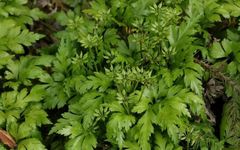Huanglian is the dried rhizome of the plants in the Ranunculaceae family, including Huanglian (Coptis chinensis Franch.), Sanjiao Ye Huanglian (Coptis deltoidea C.Y.Cheng et Hsiao), or Yunlian (Coptis teeta Wall.). These three types are commonly referred to as “Weilian,” “Yalian,” and “Yunlian.” They are harvested in autumn, with the fibrous roots and soil removed, dried, and any remaining fibrous roots are knocked off.
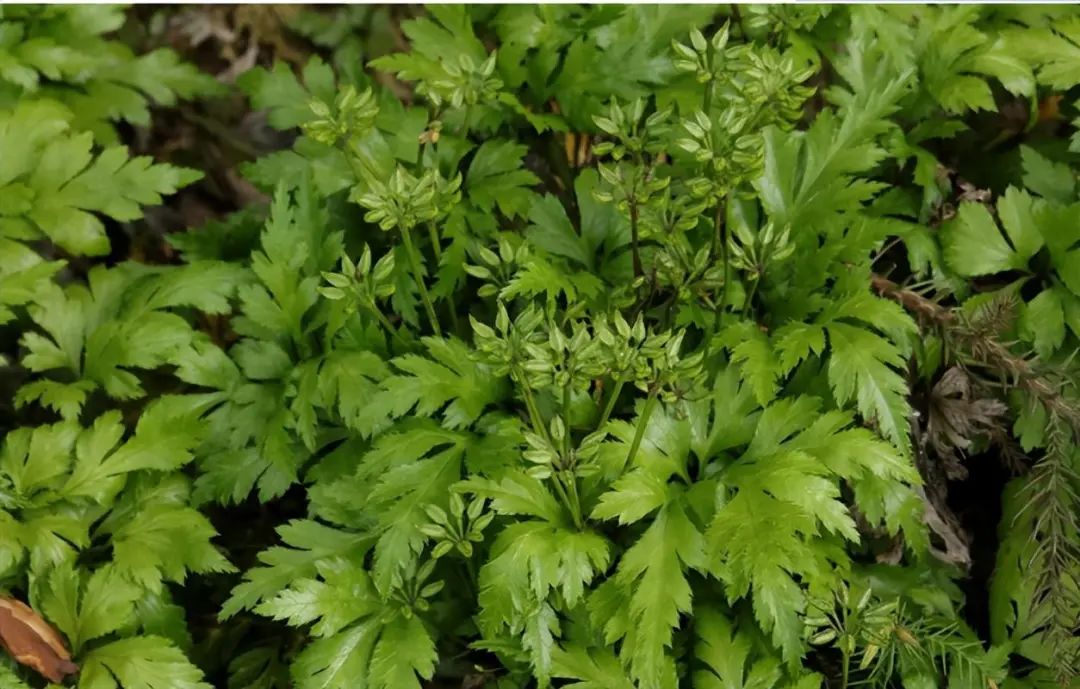
Huanglian Plant
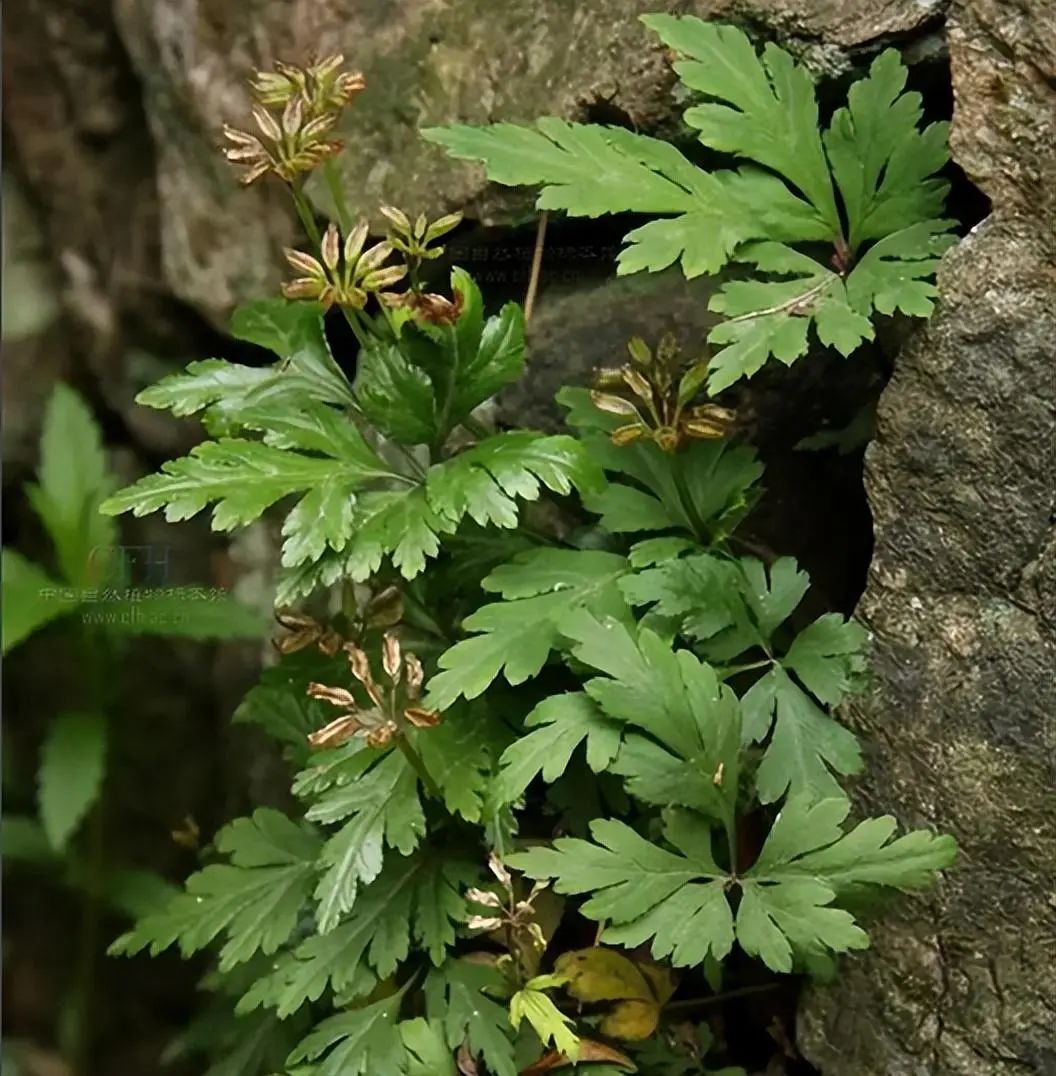
Sanjiao Ye Huanglian Plant
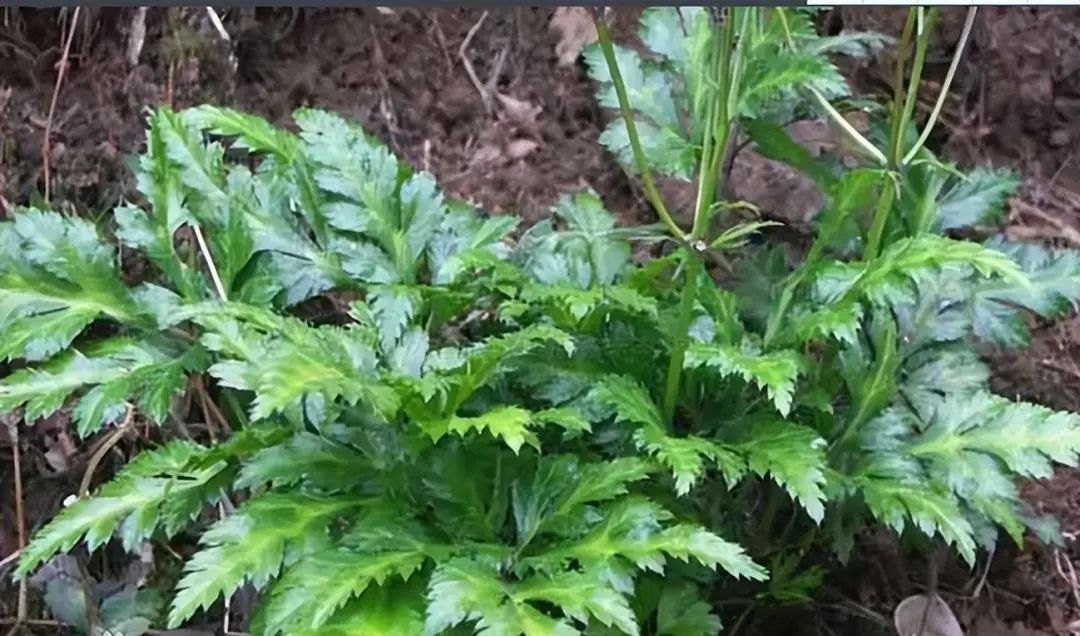
Yunlian Plant
【Characteristics】 Weilian is often clustered, usually curved, resembling a chicken’s claw, with single rhizomes measuring 3-6 cm in length and 0.3-0.8 cm in diameter. The surface is grayish-yellow or yellow-brown, rough, with irregular nodular protrusions, fibrous roots, and remnants of fibrous roots. Some segments have a smooth surface like a stem, commonly referred to as “crossing the bridge.” The upper part often retains brown scale leaves, and the tip usually has remnants of the stem or petiole. It is hard, with an irregular fracture surface, the bark is orange-red or dark brown, and the wood is bright yellow or orange-yellow, arranged radially, with some hollow pith. The aroma is faint, and the taste is extremely bitter.

Weilian Medicinal Material
Yalian is mostly single-stemmed, slightly cylindrical, slightly curved, measuring 4-8 cm in length and 0.5-1 cm in diameter. The “crossing the bridge” part is longer. The tip has a small amount of residual stem.
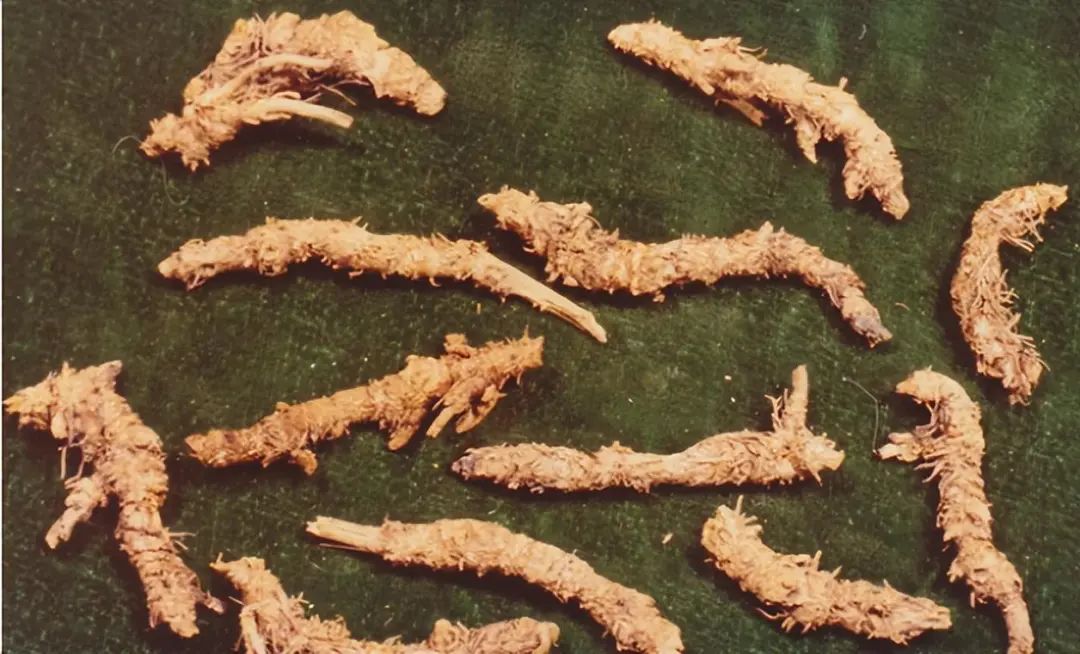
Yalian Medicinal Material
Yunlian is curved in a hook shape, mostly single-stemmed, and relatively small.
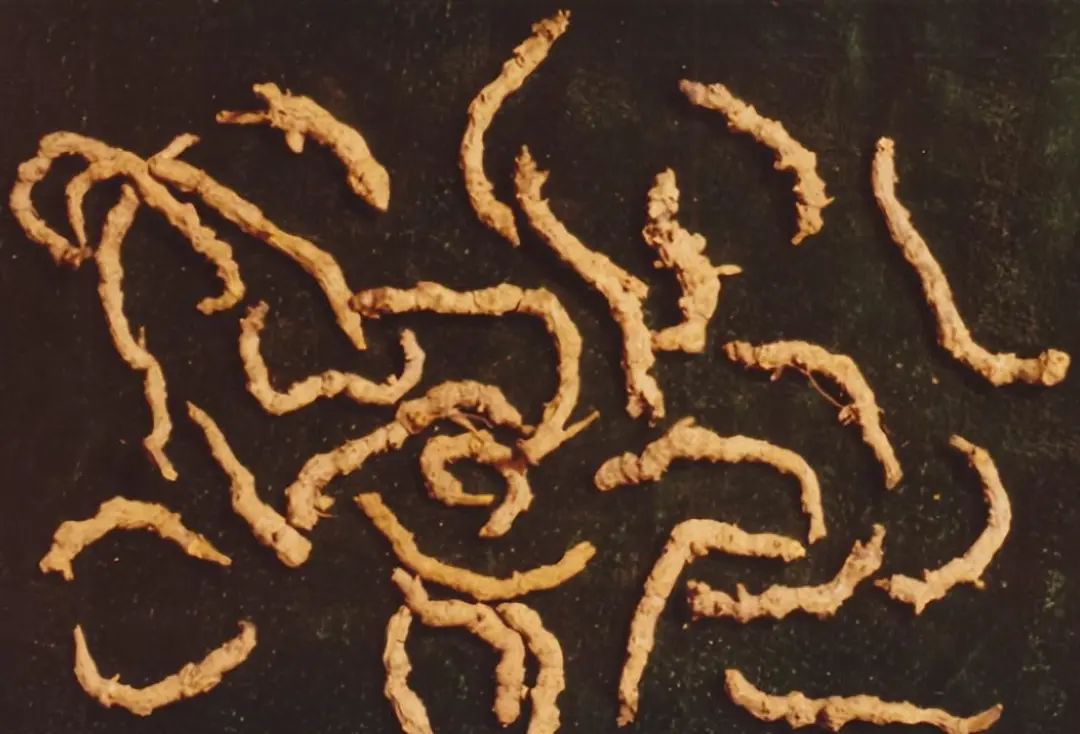
Yunlian Medicinal Material

Identification of Huanglian Characteristics
Adulterants:
1. Emei Wildlian: This is the dried rhizome of the plant Emei Wildlian (Coptis omeiensis (Chen) C. Y. Cheng). This product is mostly slightly curved and cylindrical, with few branches, measuring 3-9 cm in length and 0.3-0.9 cm in diameter. The surface is brownish-yellow, covered with scale leaves and fibrous roots. There is no “crossing the bridge,” and the tip often has a leaf petiole measuring 7-12 cm. The leaf petiole is clustered, with a smooth surface and longitudinal ridges.

Emei Wildlian
2. Inzhou Huanglian: This is the dried rhizome of the plant Japanese Huanglian (Coptis japonica Makino). This product is curved and cylindrical, with bead-like nodules, few branches, and is shorter, measuring 2-4 cm in length and 0.2-0.3 cm in diameter. The surface is grayish-yellow, with remnants of scale leaves and fibrous roots, and no “crossing the bridge”; the tip sometimes has short leaf petiole remnants.

Inzhou Huanglian
3. Tu Huanglian: This is the dried rhizome of the plant Short-sepal Huanglian (Coptis chinensis Franch. var. brevisepala W.T. Wang et Hsiao). This product is slightly bead-like and cylindrical, with few branches, often curved or semi-circular, sometimes broken into one or two connected round grains, measuring 1-3 cm in length and 0.2-0.4 cm in diameter. The surface is gray-brown, with scale leaf marks and fibrous roots.
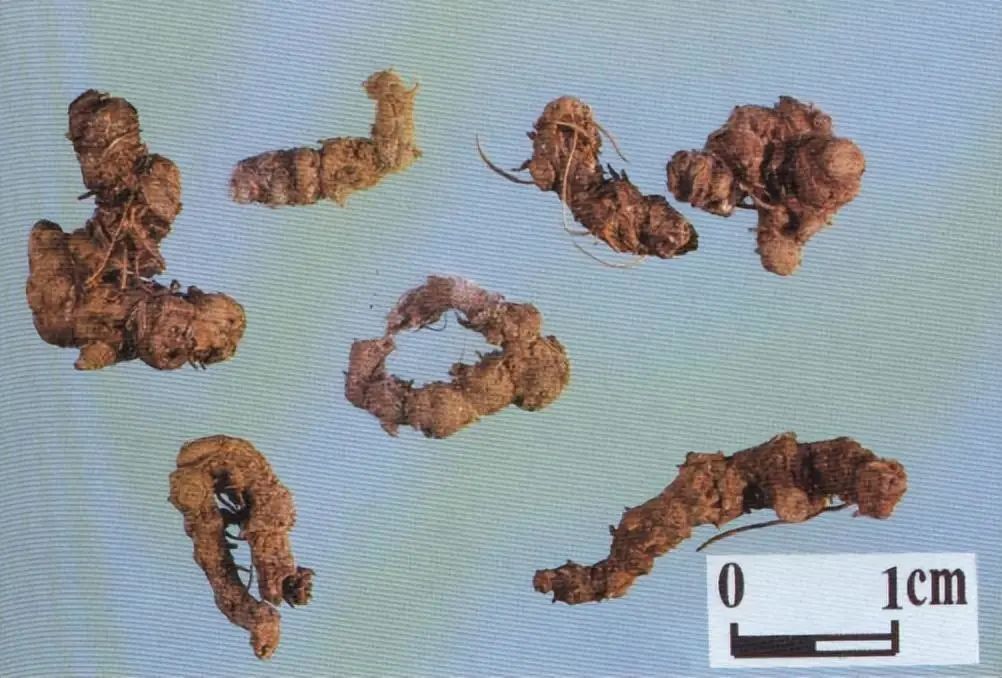
Tu Huanglian
4. Maw Tailian: This is the root and rhizome of the plant Golden-hair Maw Tailian (Thalictrum glandulosissimum (Fin. et Gagn.) W. T. Wang et S.H. Wang). This product has rhizomes that are connected in a nodular manner, with visible stem remnants. It measures 1-3 cm in length and 0.2-0.5 cm in diameter. The surface is rough, with dark brown scale leaf remnants. The texture is hard, not easily broken, and the fracture surface is bright yellow. The roots are long and clustered at the rhizome, often numbering dozens, measuring 10-25 cm in length and about 0.1 cm in diameter, with a brown cork layer that often falls off, leaving a brown-yellow, smooth surface. The roots are brittle, easily broken, with a flat fracture surface. The aroma is faint, and the taste is extremely bitter, sticking to the teeth.
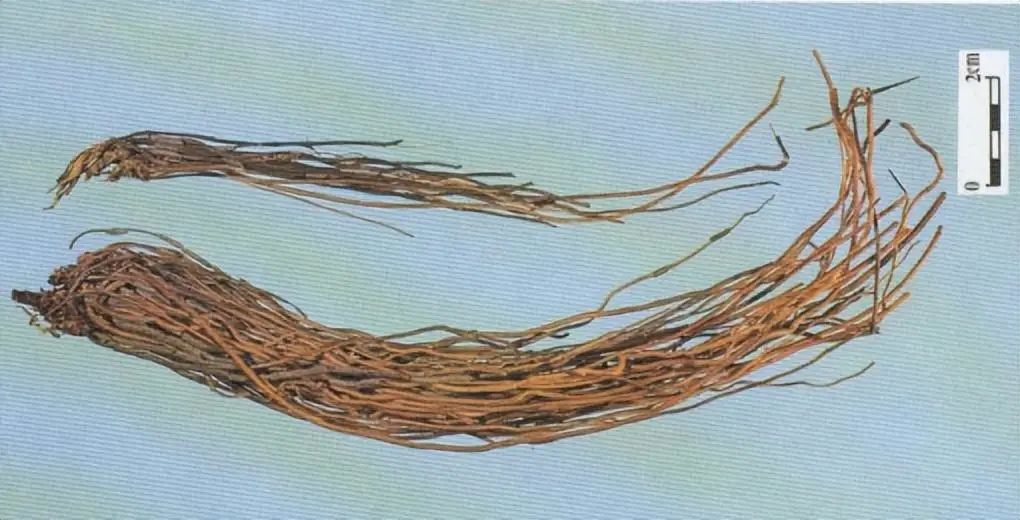
Maw Tailian
5. Multi-leaf Tang Songcao: This is the root and rhizome of the plant Multi-leaf Tang Songcao (Thalictrum foliolosum DC.). This product has horizontally growing rhizomes, with several to dozens of nodular formations, robust. The diameter is 1.5 cm, and the surface is yellow-brown, with round stem scars on top and a protruding stem base in the center. Below, there are many brown roots, with a diameter of 0.2 cm, and the outer skin of the roots is easily broken or shed, with the exposed wood appearing yellow. The fibrous roots are brittle, easily broken, with a thin bark and a central yellow round wood. The aroma is faint, and the taste is bitter.
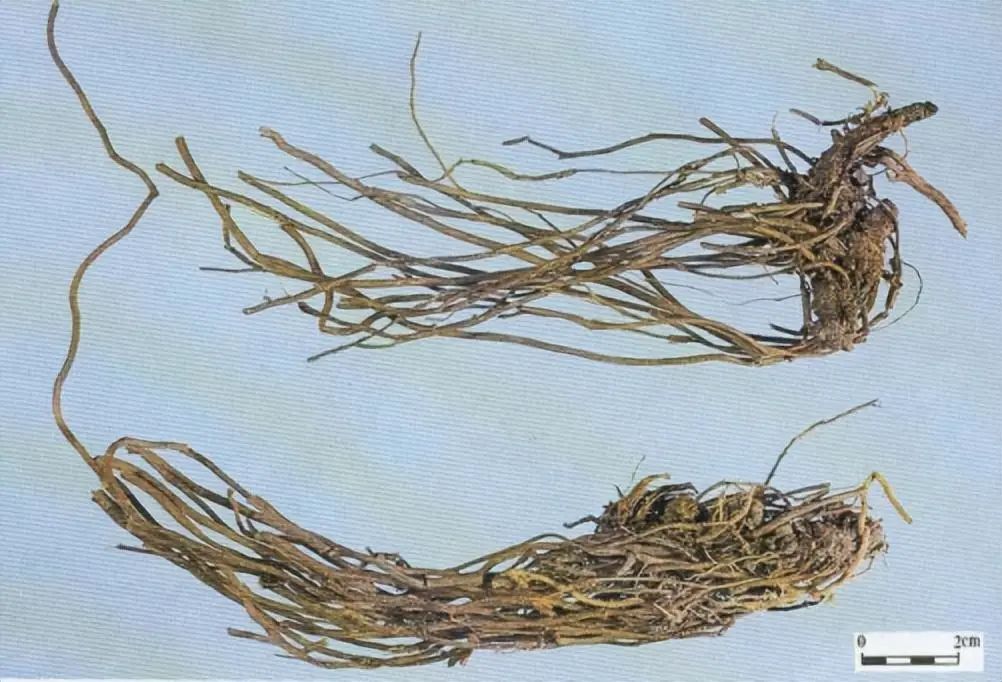
Multi-leaf Tang Songcao
6. Dian Dougen: This is the root and rhizome of the plant Iron Breaker (Beesia calthaefolia (Maxim.) Ulbr.). This product is cylindrical, branched, and curved, measuring 3-10 cm in length and 0.3-0.8 cm in diameter. The surface is brownish-yellow, with many nodes, and the node patterns are raised, with internodes measuring 0.5-2.5 cm; fine roots, root marks, and wrinkled textures can be seen. The texture is solid and brittle, easily broken, with a yellow or dark yellow fracture surface, showing a waxy luster. The aroma is faint, and the taste is bitter.
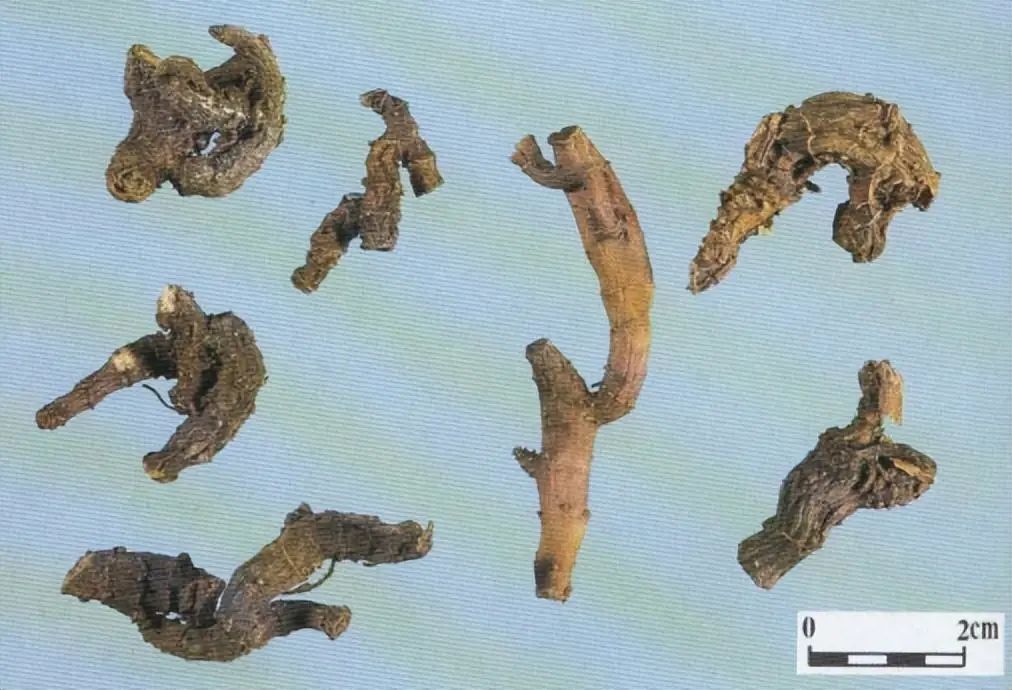
Dian Dougen
Some are artificially dyed, falsely filling Huanglian, which are counterfeit products.

Dian Dougen Dyed
7. Fresh Huanglian: This is the dried rhizome and root of the plant Fresh Huanglian (Jeffersonia dubia (Maxim.) Benth. et Hook. f.). This product is yellow-brown. The rhizome measures 2.5-7 cm in length and 0.1-0.3 cm in diameter, elongated cylindrical, slightly twisted, with branches, often having long and short dark longitudinal grooves or pits, and the rhizome surface has root marks and many slender roots. The root diameter is about 0.1 cm. The texture is relatively hard, with a fracture surface that is near yellow, solid. The aroma is faint, and the taste is slightly bitter.
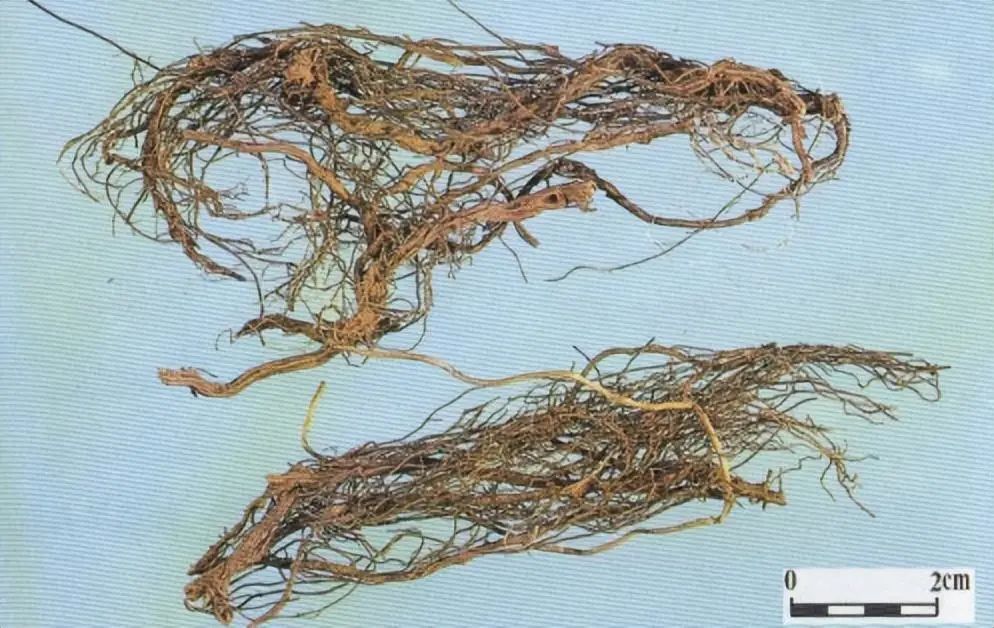
Fresh Huanglian
8. Arrow-leaf Epimedium: This is the dried rhizome of the plant Arrow-leaf Epimedium (Epimedium sagittatum (Sieb. et Zucc.) Maxim.). This product is cylindrical, measuring 1.5-4 cm in length and 0.4-0.7 cm in diameter. The surface is purple-brown, with fibrous roots and nodes, and has many buds, with the bud surface having purple-brown scale leaves, slightly glossy. The texture is hard, not easily broken, with a round fracture surface, the bark is purple-brown, the wood is light yellow-white, and the center has a round pith. The aroma is faint, and the taste is bitter.
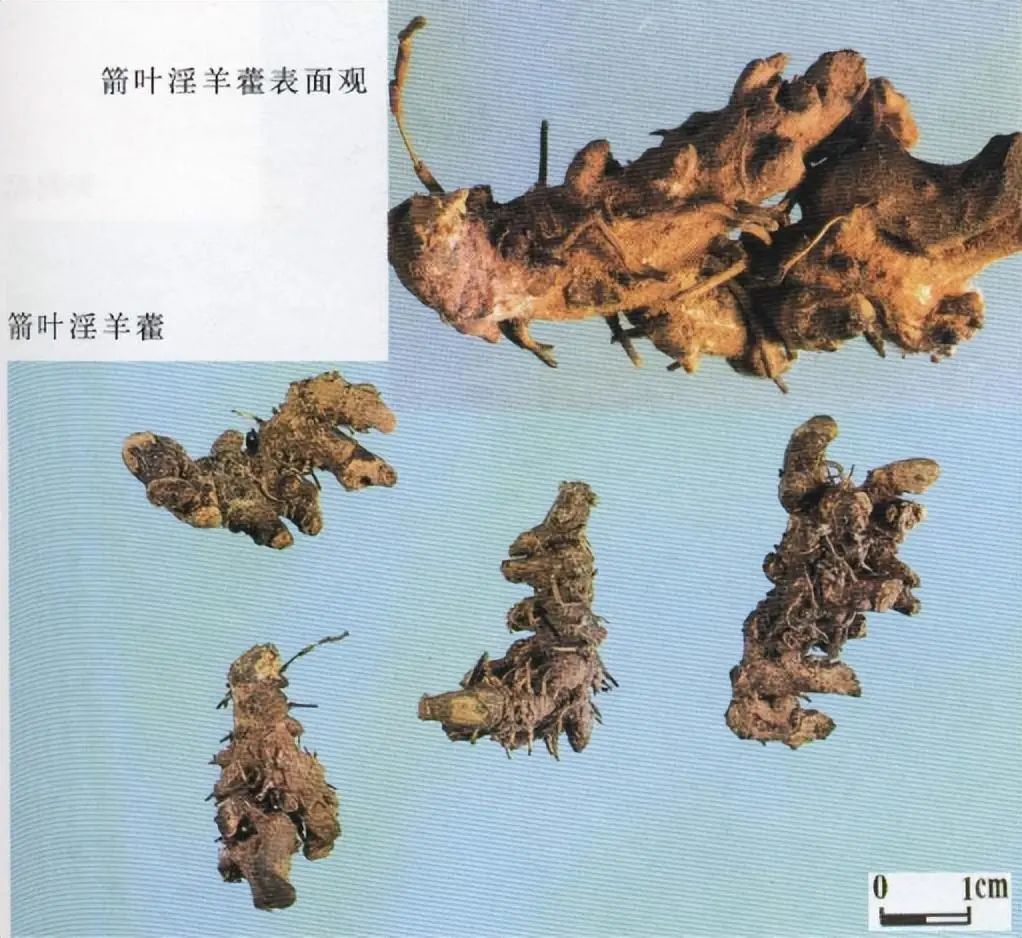
Arrow-leaf Epimedium
9. Blood Water Grass: This is the dried rhizome of the plant Blood Water Grass (Eomecon chionantha Hance). This product is irregularly spindle-shaped, measuring 2-3 cm in length and about 1 cm in diameter. The surface is brownish-yellow, often with scale-like leaf bases at the top, and one end is often enlarged. The texture is hard and brittle, with a fracture surface that is yellow-white, some slightly keratinous, with brownish-yellow small dots visible. The aroma is faint, and the taste is bitter.
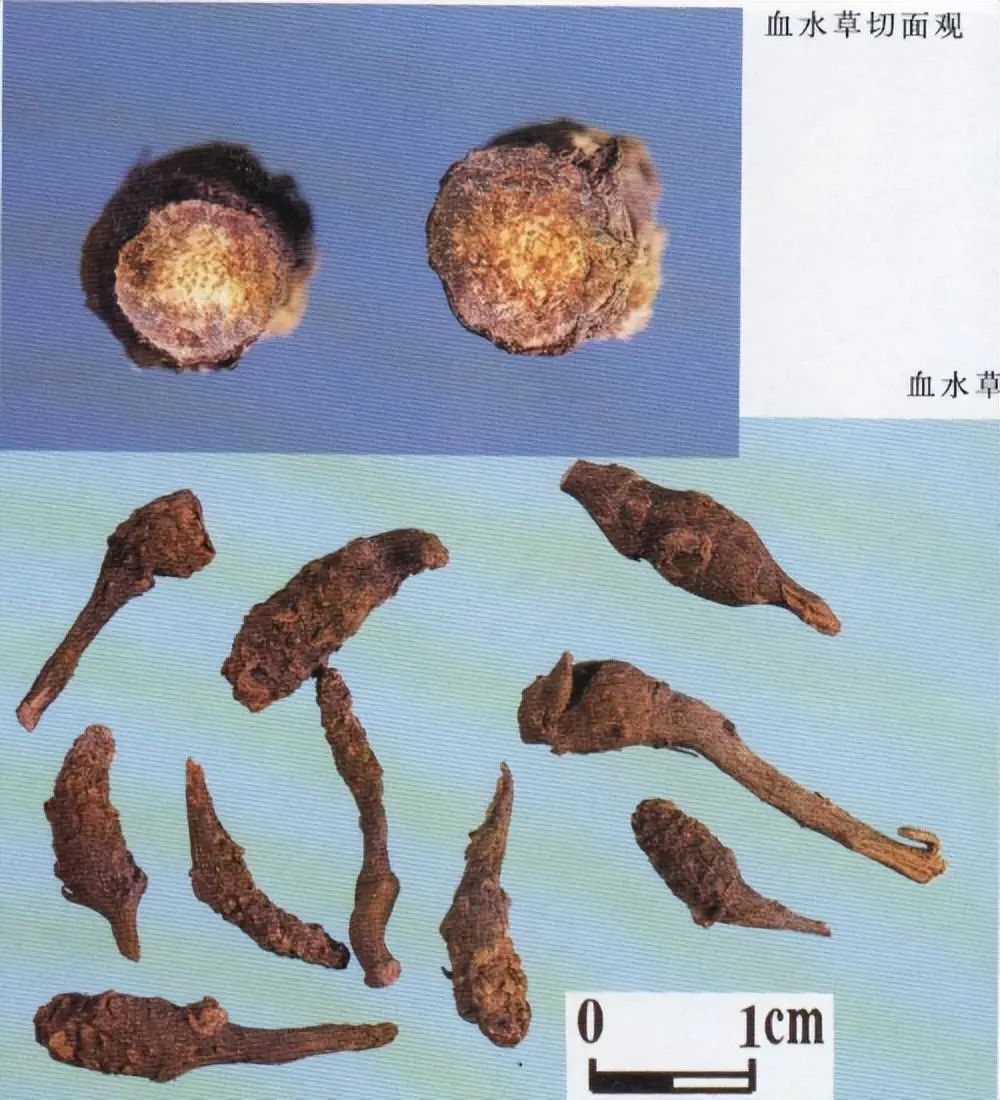
Blood Water Grass
10. Wild Chicken Tail: This is the dried rhizome of the plant Wild Chicken Tail (Onychium japonicum (Thunb.) Kze.). This product is brownish-yellow, cylindrical, some branched, slightly curved or wavy. It measures 3.5-5.5 cm in length and 0.3-0.5 cm in diameter. The surface has raised round leaf base remnants, with short fibrous roots and brown scales. The texture is brittle, easily broken, with a fracture surface that is brownish-yellow, showing 3-5 pale yellow central columns. The aroma is faint, and the taste is bitter.
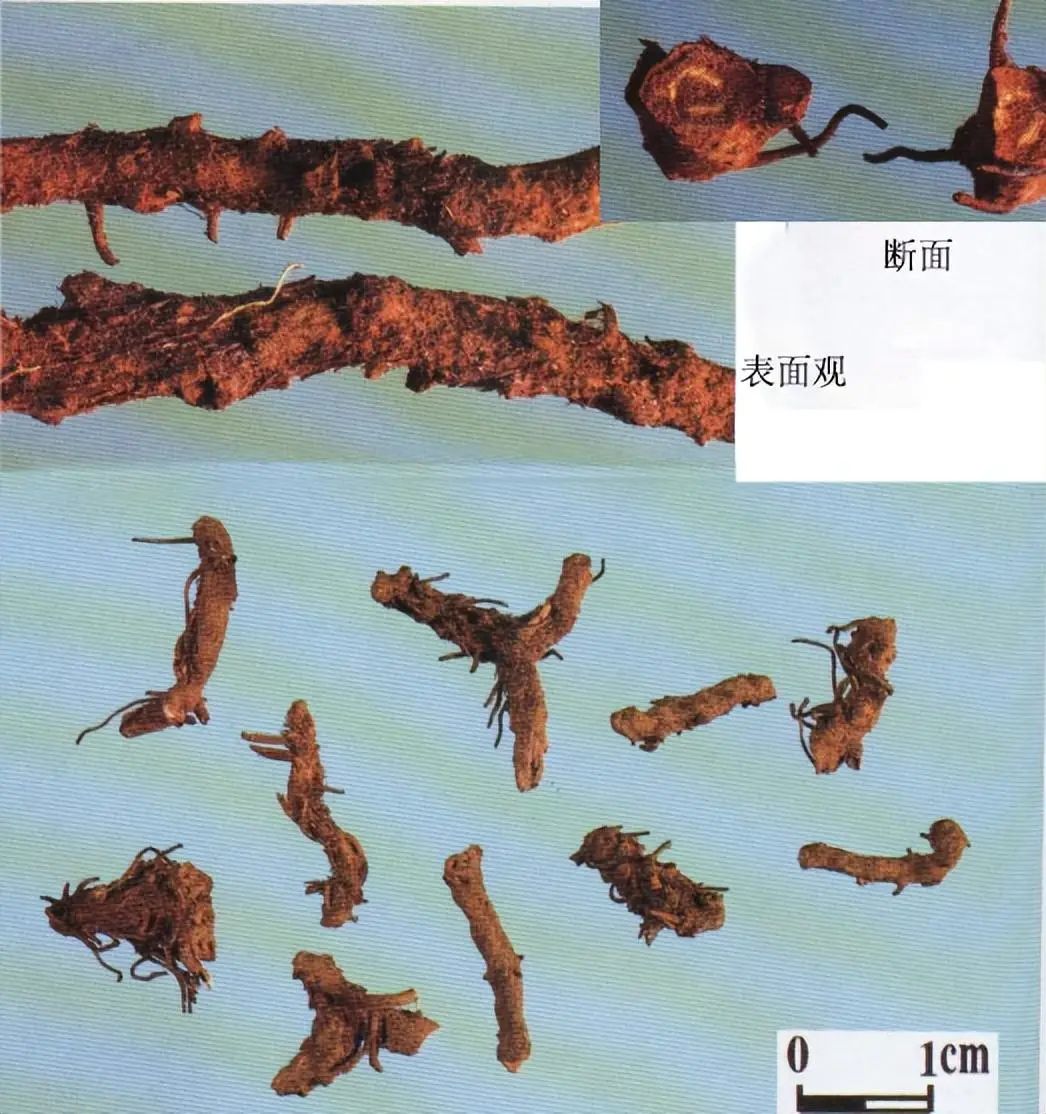
Wild Chicken Tail
11. Stone Silkworm: This is the dried rhizome of the plant Stone Silkworm (Polypodium nipponicum (Mott) Chipj). This product is irregularly cylindrical, slightly curved, measuring 2.5-4 cm in length and 0.2-0.5 cm in diameter. The surface is brownish-yellow or blackish-brown, with round protrusions and fibrous root marks. The texture is hard, easily broken, with a fracture surface showing discontinuous ring-like arrangements of central columns. The aroma is faint.

Stone Silkworm
【Processing】 Huanglian slices are cleaned of impurities, soaked, then sliced thinly and dried, or crushed when used.
【Characteristics】 This product appears as irregular thin slices. The outer skin is grayish-yellow or yellow-brown, rough, with small fibrous roots. The cut surface or broken surface is bright yellow or red-yellow, with radial textures, the aroma is faint, and the taste is extremely bitter.
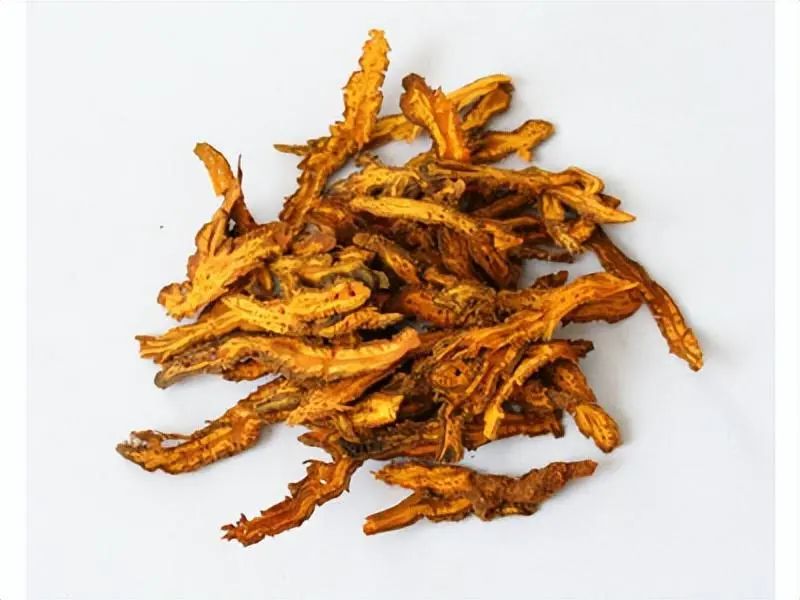
Huanglian Slices
Jiu Huanglian: Take clean Huanglian, and stir-fry with wine according to the wine-frying method (General Rule 0213). For every 100 kg of Huanglian, use 12.5 kg of yellow wine.
【Characteristics】 This product resembles Huanglian slices, with a deeper color. It has a slight wine aroma.
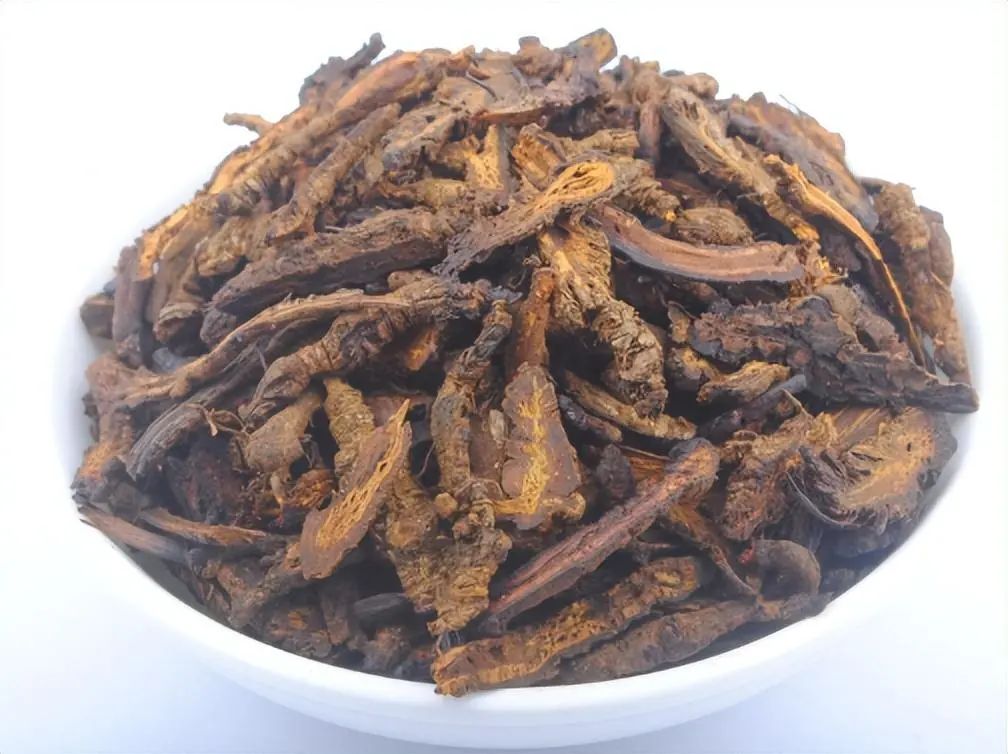
Jiu Huanglian Drink Slices
Ginger Huanglian: Take clean Huanglian, and stir-fry with ginger juice according to the ginger-frying method (General Rule 0213). For every 100 kg of Huanglian, use 12.5 kg of fresh ginger.
【Characteristics】 This product resembles Huanglian slices, with a brown-yellow surface. It has a spicy flavor of ginger.
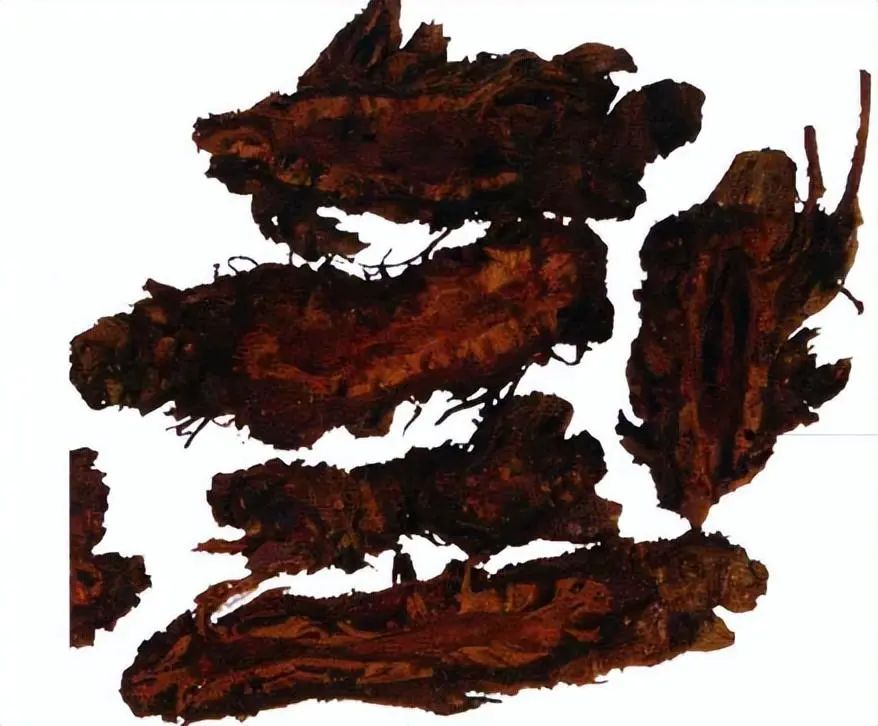
Ginger Huanglian Drink Slices
Yu Huanglian: Take Wu Zhu Yu and an appropriate amount of water to decoct, mix the decoction with clean Huanglian, and dry after the liquid is absorbed. For every 100 kg of Huanglian, use 10 kg of Wu Zhu Yu.
【Characteristics】 This product resembles Huanglian slices, with a brown-yellow surface. It has a spicy aroma of Wu Zhu Yu.

Yu Huanglian Drink Slices
【Chemical Composition】
The roots or stems contain various isoquinoline alkaloids, with the highest content of berberine, ranging from 5-8%, and also contain coptisine, methylcoptisine, palmatine, jatrorrhizine, epiberberine, and magnoflorine, among others. Acidic components include ferulic acid, chlorogenic acid, etc. The fibrous roots can contain up to 5% berberine, and Huanglian leaves also contain berberine.
【Pharmacological Effects】
1. Antibacterial effects
2. Antifungal effects
3. Antiviral effects
4. Antiamoebic effects
5. Anti-inflammatory and anti-diarrheal effects
6. Effects on the cardiovascular system
7. Antipyretic effects
8. Blood sugar lowering effects
9. Blood lipid lowering effects
10. Antioxidant effects
11. Effects on the blood system
12. Anti-ulcer effects
【Taste and Properties】 Bitter, cold. It enters the Heart, Spleen, Stomach, Liver, Gallbladder, and Large Intestine meridians.
【Functions and Indications】 Clears heat and dries dampness, drains fire and detoxifies. Used for damp-heat fullness, vomiting with sour regurgitation, diarrhea, jaundice, high fever with delirium, excessive heart fire, irritability and insomnia, palpitations, blood heat with vomiting and nosebleeds, red eyes, toothache, thirst, carbuncles, and sores; externally used for eczema, damp sores, and ear discharge. Jiu Huanglian is good for clearing heat from the upper jiao. Used for red eyes and oral ulcers. Ginger Huanglian clears the stomach and stops vomiting. Used for cold-heat counterflow, damp-heat obstruction, fullness, and vomiting. Yu Huanglian soothes the liver and stomach and stops vomiting. Used for liver-stomach disharmony, vomiting with sour regurgitation.
【Dosage and Administration】 2-5 g. For external use, an appropriate amount.
【Storage】 Store in a ventilated and dry place.
Note: This article aims to promote the culture of Traditional Chinese Medicine, and the TCM knowledge mentioned is for learning and exchange purposes only.
WeChat has been updated! If youneither★starred me nor liked or “looked at” my articles, the system will assume you do not need to know about herbal medicine knowledge, and in the end,you will not receive our article updates
End of the article. Thank you for your patience in reading. If you find it good, please click on the bottom “ “Like” and “
“Like” and “ “Look”~
“Look”~
As the ancient saying goes, “When three people walk together, there must be a teacher among them.” To facilitate the integration of knowledge among practitioners of Traditional Chinese Medicine, mutual exchange, and collective growth. A comprehensive knowledge base of herbal medicine is being prepared to establish a discussion group. If you wish to join, please add the editor’s WeChat and indicate your identity. The editor invites you to join the group.


